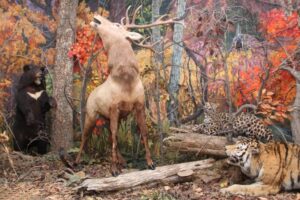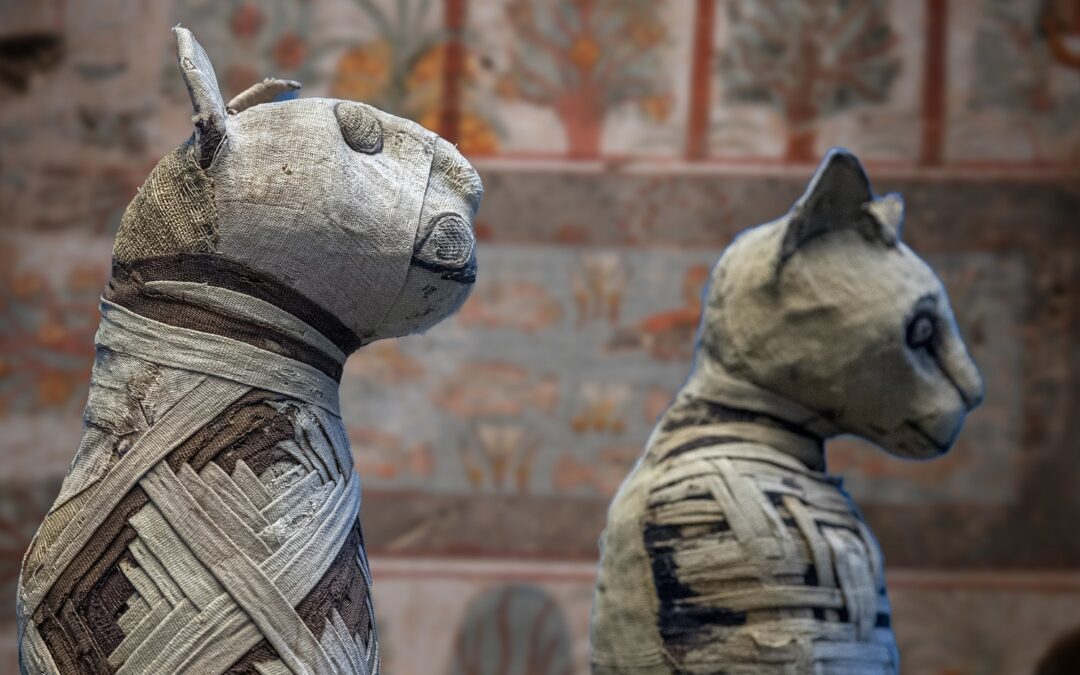Early Forms of Taxidermy
In ancient Egypt, taxidermy was not used as a means to put animals on display, but rather, to preserve animals that were pets or were beloved by pharaohs and other nobility. They developed the first type of preservation of both humans and animals through the use of embalming tools, spices, injections, and oils.
The purpose of the preservation of animals was so that they could be buried alongside the pharaoh or nobility. One of the most notable animals the Egyptians preserved was a hippopotamus. While their methods were not used to put animals on display, it did pave the way for further developments and new taxidermy techniques.
Early Preservation of Animal Hides
Renewed Development and New Techniques
Not only were people interested in preserving animal skins and hides but also in recreating life-like representations of the animals as a form of art. It was during this time that early museums also first started to become interested in creating displays featuring a wide range of wild animals for people to see up close.
The popularity continued to grow throughout this period. In the Netherlands in the 1600s, the first attempts were made to preserve and mount birds. The first large-scale animal mounted was in the 1500s at the Royal Museum in Florence, Italy, where they used taxidermy techniques of the time to create a rhinoceros display.
In Switzerland in the 1600s, the Museum at St. Gall had acquired a preserved crocodile from Egypt for a display.
Further Developments in Taxidermy During the 18th and 19th Centuries
After the fall of Napoleon, the museum continued to grow and continued to develop more modern techniques for recreating life-like animal displays. In 1851, the museum hosted The Great Exhibition, featuring displays of animals from all around the world.
Early Taxidermy Methods
However, as you can imagine, the results were less than perfect. In some cases, the animals no longer looked natural. Some early taxidermists also were challenged with recreating life-like representations when they had never seen the wild animal in nature before.
This led to some errors in judgment, which resulted in “epic fails.” Some of the animals were more cartoonish than realistic when completed. Yet, the people of the time had no idea. They assumed the representation was accurate.
Advances in Taxidermy Methods in the 18th and 19th Centuries

The use of Styrofoam, metal rods, and wire frames started to replace using skeletons. Styrofoam could be cut and shaped so that it looked more natural once the skin was placed around the frame. Metal rods could be inserted into Styrofoam to provide “bone-like” support for legs, heads, and tails. Wire was also used for more delicate appendages.
Advances in Taxidermy in the 20th Century
For numerous years, the methods to prepare and preserve animals relied on using various methods. For instance, to prepare bones, after the hide or skin was removed, the carcass was buried in the ground and left until nature took its course.
Other popular methods used included:
- Boiling the Flesh: This method involved boiling the carcass until the flesh fell off the bone. While it was initially useful in prepare skeletons to serve as the framework for “stuffed” animal displays, the bones can get damaged.
- Soaking the Flesh: This method placed the carcass into a vat of water and just allowed it to soak until the flesh softened up. Then it was pulled off the bones. This method also required using tools to scrape the flesh off and led to damaged bones.
- Chemicals: Tanning hides and skins relies on using various chemicals. These same chemicals are used to dissolve flesh from the carcass and prepare skeletons. However, chemicals can damage bones and make them brittle.
In the 1970s, there was a renewed interest in the art of taxidermy. Taxidermy competitions started to be held all across the country. This was the first time that taxidermists could share their methods with each other and learn new ones that improved the end results.
In the 1980s, museums started to use flesh-eating beetles, called Dermestid beetles, to remove flesh from carcasses. The purpose of using beetles was that it left the bones clean while preserving their structures, including delicate nasal bones.
Forensic scientists took notice. They believed that the use of Dermestid beetles for scientific purposes and forensics could be beneficial. For instance, if police were investigating a suspicious death where the body was mangled, they could remove the flesh and preserve the bones to determine injuries to the bones and, potentially, the cause of death.
Gradually, taxidermists also started using Dermestid beetles to clean the flesh from carcasses when they were creating European mounts (skull mounts), skeleton mounts, or needed parts of the skeleton to create a trophy mount or life-size replica.
This form of taxidermy was popular in European and Native American societies. The skins and hides of animals were preserved and used for a wide range of purposes, including clothing and bedding. Some early societies also preserved animal hides for cultural or religious purposes.
Benefits of Modern Taxidermy
Modern taxidermy offers several benefits, not just for creating a stunning trophy mount or skull mount, but also for:
- Preserving species that have become extinct.
- Creating modern art that features the use of 3D objects and animals.
- Determining the cause of death of animals in unusual circumstances.
- Helping advance various scientific methods to identify viruses in animals.
- Developing vaccines for viruses in animals that can be transferred to humans.
The Future of Taxidermy

Aside from technology, another driving factor that is creating a new interest in taxidermy is it allows people to disconnect from the internet and social media. With so many people spending countless hours on computers, online, and on social media, they are discovering it is refreshing to spend time touching and working with physical specimens.
Some people even enjoy taxidermy to release stress and anxiety. They find it therapeutic to be able to create something that they can put on display at their home or work. In addition, many people are discovering it can be fun, exciting, and educational to raise their own Dermestid beetle colonies.
Taxidermy has come a long way since ancient Egypt, and it has evolved into a form of art and science to preserve and better understand animals.
If you are interested in preserving animal skulls or creating a skull mount, or you want to start a colony of skull-cleaning beetles beetles, please feel free to contact Kodiak Bones & Bugs Taxidermy at (907) 942-2847 today!

